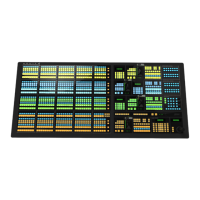• Reject — include or reject adjacent hues to the
base. Increasing the reject value increases the
amount of adjacent hues that are included in spill
correction. Decreasing the reject value decreases
the amount of adjacent hues that are included in
spill correction.
13. Press Edge Softness and use the Softness,
Width, and Additive Keying knobs to adjust the
edges of the foreground.
Note: Edge softness is not available if the chroma key is
being used by a floating DVE key.
Note: If the Width adjustment is set greater than Off, the
Sensitivity is automatically set to Low. The Sensitivity is set
back to what it was before when Width is set back to Off.
Tip: The default Width and Additive Keying settings can
be adjusted using the UltraChrome Dflt Width setting on
the Personality menu.
• Softness — add or remove edge softening of
the foreground image and alpha channel.
Increasing the softness value increases the
amount of softness applied to the foreground
edges and alpha channel. Decreasing the softness
value decreases the amount of softness applied
to the foreground edges and alpha channel.
• Width — adjust the outside edge of the
foreground image and alpha channel. Increasing
the width value increases the amount that the key
encroaches onto the foreground image.
Decreasing the width value decreases the amount
that the key encroaches onto the foreground
image.
• Additive Keying — set the edge sensitivity.
• Off — reduce the level of detail in the edges
of the chroma key. This option will reduce
the overall noise in the key image that can be
the result of certain lighting conditions or
high detail camera settings.
• On — include the maximum detail in the
edges of the chroma key.
14. Press Luminance and use the Reflections and
Bkgd Supress knobs to adjust the luminance, or
brightness. The luminance settings allow you to
adjust the overall brightness of the Shadow,
Translucent, and Transition areas to change the
appearance of reections from semi-transparent
objects and to match Shadow and Transition area
brightness with the Foreground brightness.
• Reflections — change the brightness of
semi-transparent reections (like reections from
glasses). Increasing the reections value
increases the brightness of semi-transparent
reections. Decreasing the reections value
decreases the brightness of semi-transparent
reections.
• Bkgd Supress — change the overall brightness
of Shadow, Translucent, and Transition areas.
Increasing the background luminance value
increases the brightness of Background,
Translucent, and Transition areas. Decreasing
the background luminance value decreases the
brightness of Background, Translucent, and
Transition areas.
Chroma Key Alpha and Color Map
Note: The alpha and color map features are not available if the
chroma key is being used by a floating DVE key.
Adjusting a chroma key can be difcult when looking at
the actual video signals. Some adjustments have very
subtle effect on the image. Using an Alpha or Color Map
preview gives you a visual representation of the various
parts of your UltraChrome chroma key and makes for
easier adjustments. The Alpha and Color Map previews
use the Preview output of the selected ME to show a
representation of the Alpha (used by the Keyer to mix
the key with the underlying background video) or a
color-coded representation of the different UltraChrome
regions. The Preview output shows the representation in
the foreground of the Preview, but not over top of the
Preview Overlay.
Tip: The Color Map can also be assigned to a configurable
program output.
Turn the Color Map (Color Map) or Show Alpha
(Alpha) on from the UltraChrome menu 2-2. The
preview output of the ME changes to the Color Map or
Alpha. Both the Color Map and Show Alpha cannot be
turned on at the same time.
Table 10: Color Map Areas Legend
AdvancedBasicColor
Background and
Shadow
n/aRed
Translucentn/aGreen
ForegroundBlack
Spill SuppressionBlue
Transition
BackgroundGray
Preset Pattern Key
A Preset Pattern key is a key in which a hole is cut based
on a wipe pattern that you select. The pattern, which acts
50 • Keying — Acuity Operation Manual (v9.2)

